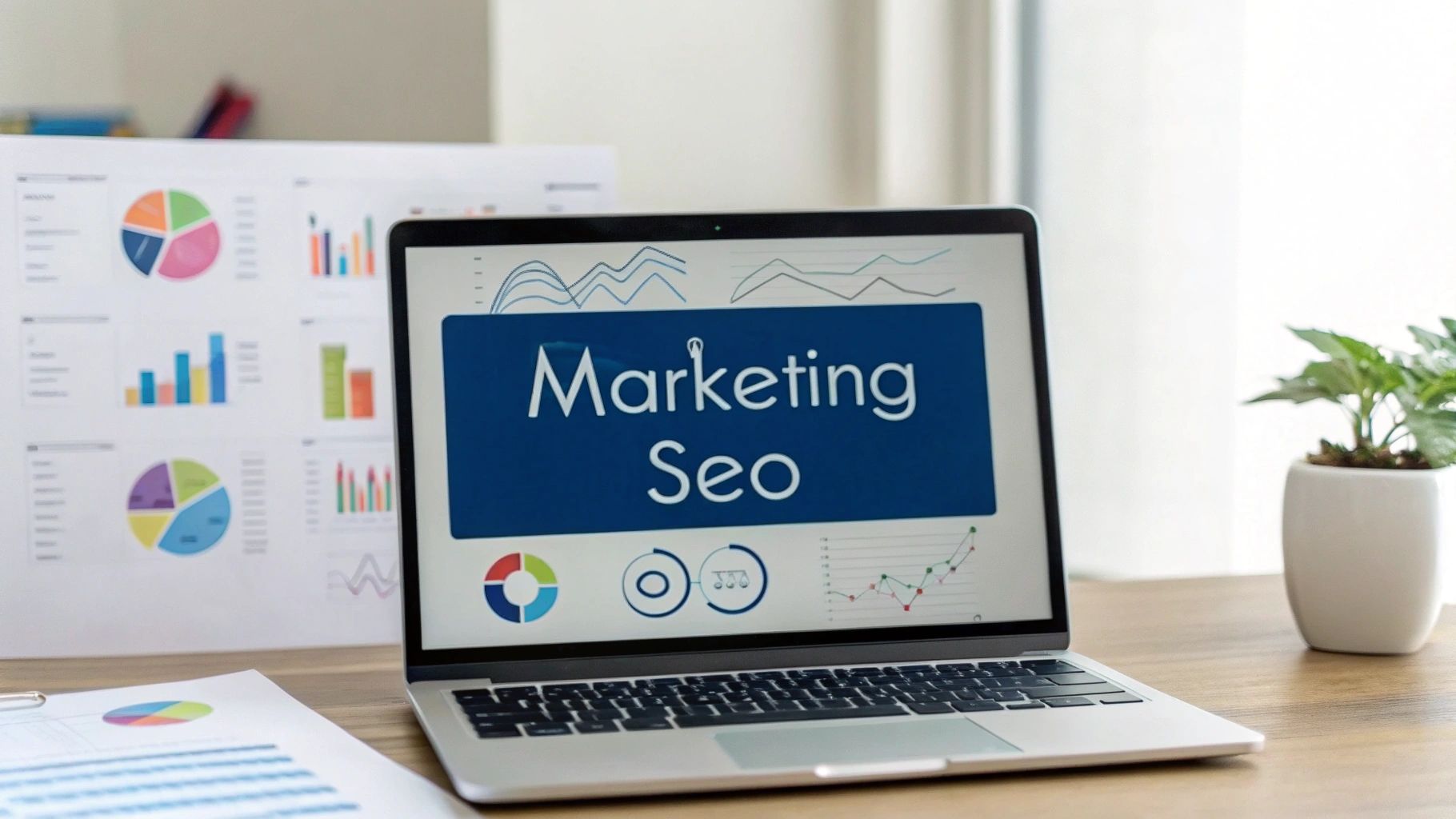How to Launch Shopify Store: The Complete Success Blueprint

Why Shopify Rules the E-commerce World

So, you're thinking about opening a Shopify store? Great idea! Before you jump in, let's explore why Shopify has become the go-to platform for e-commerce entrepreneurs, both new and experienced. It offers a powerful combination of user-friendliness and robust features, making it a smart choice for businesses of all sizes.
Accessibility and Scalability for All
One of Shopify's biggest draws is its intuitive interface. The drag-and-drop functionality makes designing your store a breeze, even if you have zero coding skills. This ease of use is a major reason why so many merchants choose Shopify. And as your business grows, so can your Shopify store. Its scalability ensures it can handle increasing traffic and order volume, keeping your customers happy.
For example, imagine you're starting a small, handmade jewelry business. Shopify makes it easy to set up a professional online storefront, manage your inventory, and process orders. As your brand takes off, you can seamlessly expand your product offerings, reach new customers through integrated marketing tools, and even explore international sales, all within the same platform.
Robust Ecosystem and Support
Shopify offers more than just its core features. It boasts a rich app ecosystem allowing you to integrate a wide range of tools and services. From email marketing and social media integration to advanced analytics and inventory management solutions, there’s an app to meet almost any need. This helps streamline your operations so you can concentrate on growing your business.
And if you ever run into trouble, Shopify's comprehensive support resources are there to help. Whether you prefer self-service options like their help center and community forums, or you need to speak directly to their support team, assistance is readily available. This is especially helpful when you're just starting out.
Market Dominance and Global Reach
When you launch a Shopify store, you're tapping into a massive platform. As of 2025, Shopify powers 5.54 million active e-commerce stores worldwide, which accounts for 27% of all online stores. Find more detailed statistics here. This impressive market share speaks to Shopify's user-friendly design, drag-and-drop features, and seamless integrations.
Over 2 million merchants in 175 countries use Shopify. This widespread adoption demonstrates Shopify's dominance in the e-commerce landscape and highlights the potential it offers new businesses. Plus, being part of such a large network connects you to a supportive community of fellow Shopify merchants. You can share best practices, learn from others' experiences, and build valuable connections. Choosing Shopify isn’t just about building a store; it’s about joining a vibrant ecosystem of entrepreneurs and innovators.
Planning Your Store Launch That Actually Works

Launching a successful Shopify store takes more than just amazing products. It's like building a house: a strong foundation is essential. This means understanding your target market, knowing what makes your store special, and having a practical plan.
Defining Your Target Audience and Niche
First, figure out exactly who your ideal customer is. What are their needs and what are they looking for? Understanding your target audience shapes everything about your store, from the products you offer to how you market them. For example, if you sell handmade jewelry, your target audience might be people who appreciate unique, handcrafted items. Knowing this helps you tailor your message and connect with them.
Defining your niche is also key. Instead of trying to appeal to everyone, focus on a specific part of the market. This specialization helps you become an expert and cater to a dedicated group, making it easier to stand out.
Crafting a Unique Selling Proposition
Once you know your audience, you need to define what sets your store apart. This is your unique selling proposition (USP). Your USP could be anything from offering personalized customer service to having an eco-friendly focus. A strong USP attracts and keeps customers in a competitive market.
Developing a Realistic Timeline and Budget
Launching a Shopify store requires both time and money. A realistic timeline and budget keep you organized and reduce stress. Your timeline should include major steps like setting up your store, adding products, and starting your marketing. Your budget should cover all costs, from Shopify fees to marketing expenses.
Before we delve into resource allocation, let's take a look at the exciting growth of the Shopify platform. The number of Shopify stores has more than doubled, from 2,127,583 in 2023 to about 4,790,000 in the second quarter of 2024. This growth shows the platform's popularity and the potential for new businesses. Learn more about this growth. This growth also means more competition, making good planning even more critical.
To help you get organized, we've put together a handy checklist:
Essential Pre-Launch Planning Checklist: A comprehensive checklist of tasks to complete before launching your Shopify store
This checklist helps you track your progress and ensure a smooth launch. Remember, each stage is important for your overall success.
Allocating Resources Strategically
Finally, a successful launch relies on resource allocation. This means focusing your time, energy, and budget on the most impactful activities. For a new Shopify store, this often includes professional product photos, compelling product descriptions, and targeted marketing. By concentrating on these key areas, you can maximize your chances of a successful launch and build a flourishing online business.
Setting Up Your Store Without Technical Headaches

So, you've got a solid plan. Great! Now, let's get your Shopify store up and running. Don't worry if tech isn't your strong suit; we'll break down the setup process into easy-to-follow steps. This section covers everything from creating your account to configuring those all-important settings.
Creating Your Shopify Account and Selecting a Plan
First things first, head over to the Shopify website and sign up for a free trial. This gives you a chance to explore the platform and its features before committing to a paid plan. Once your trial is over, choosing the right plan is essential. Shopify offers a variety of plans to suit different budgets and business needs. Think about how many products you plan to sell, your anticipated sales volume, and the features you'll need.
Choosing a plan is a bit like choosing an apartment. A studio might work for one person, but a growing family needs more room. Likewise, the Basic Shopify plan might be perfect for a small startup, while a larger business might benefit from the added features and scalability of the Shopify or Advanced Shopify plan.
Configuring Your Domain and Payment Gateways
Next up, your domain name. This is your online address and a key part of your brand identity. You can buy a new domain through Shopify or connect an existing one, giving your store that professional look.
Connecting payment gateways is crucial, too. This is how you’ll receive payments from your customers. Shopify integrates with various payment providers. Pick options that are popular with your target audience and offer reasonable transaction fees. Offering a variety of payment options can really boost your conversion rates.
Setting Up Shipping and Taxes
Shipping can seem complicated, but Shopify makes it easier. You can set up real-time shipping rates from carriers like UPS, USPS, and FedEx, or offer flat-rate shipping. The goal is to find a balance between keeping your profits up and offering competitive shipping costs to your customers. This keeps customers happy and ensures you don’t lose money on shipping.
Taxes are another important part of running an online store. Shopify simplifies this by automatically calculating sales tax based on your location and your customer's location. This automation saves you time and hassle, minimizing the risk of errors. Accurate tax calculations also build trust with your customers.
Essential Admin Settings for a Smooth Launch
Shopify's admin panel is packed with settings to customize your store. Some are vital for launch, while others can be tweaked later. For instance, setting up your store’s general information, like your store name, contact info, and legal pages, is essential. Other settings, like email marketing integrations, can be fine-tuned after launch. Focusing on the essentials first lets you concentrate on what really matters when launching your store, streamlining the process and getting you up and running quickly.
Designing Your Store That Converts Visitors to Buyers

Now that your Shopify store's backend is all set up, let's turn our attention to what your customers will see: the design. This is where you'll transform your store from just a website into a thriving business. A well-designed store doesn't just look nice; it encourages visitors to become buyers and helps you effectively launch your Shopify store.
Selecting the Right Theme for Your Niche
Your Shopify theme is the foundation of your store's design. It determines the overall look and feel, shaping how customers perceive your brand. There are hundreds of free and paid themes available on Shopify, each with its own set of features and customization options. Choosing the right theme is key to creating a positive first impression and boosting sales.
For example, a minimalist theme might be perfect for a high-end fashion brand, while a colorful, playful theme could be better for a store selling children's toys. When choosing a theme, think about who your target audience is and what kind of products you sell.
To help you make the best choice, take a look at this comparison of some popular Shopify themes:
To help you in choosing the right theme, the following table summarizes some key features of some popular Shopify themes:
Shopify Theme Comparison
This table gives you a starting point for exploring different themes and their suitability for your specific needs. Remember to test out a few themes before settling on one.
Customizing Visual Elements to Build Trust
Once you've chosen a theme, customize it to reflect your brand's identity. This includes selecting the right color palette, fonts, and imagery. These visual elements work together to create a cohesive brand experience and build trust with your customers.
Think of your online store like a physical storefront. You'd carefully choose the decor and layout of a physical store, right? The same applies to your online store. High-quality product photos, clear product descriptions, and a well-organized layout all contribute to a positive customer experience. Displaying trust badges and security seals can also build customer confidence.
Creating Intuitive Navigation for Seamless Shopping
Navigating your store should be easy for customers. Intuitive navigation guides visitors to where they want to go – the checkout page. A clear and logical menu structure, paired with a prominent search bar, ensures customers can easily find what they're looking for.
Imagine a customer searching for a specific product. If they can’t find it quickly, they’re likely to leave and shop elsewhere. A streamlined navigation experience minimizes frustration and increases the chances of a sale.
Optimizing for Mobile: Reaching Customers on the Go
With so many people shopping on their phones, mobile optimization is essential. Your store should be responsive, adapting to different screen sizes and devices. This provides a consistent shopping experience, no matter how customers access it.
This means ensuring your store loads quickly on mobile, the text is easy to read, and the navigation is intuitive. Even small details like button size and placement can significantly impact the mobile shopping experience. A mobile-first approach can dramatically improve conversion rates and customer satisfaction.
By focusing on these design elements, you can create a Shopify store that not only looks fantastic but also converts visitors into paying customers. This leads to increased sales, builds brand loyalty, and ultimately, creates a successful online business. Next up, we'll cover adding products to your store.
Building Your Product Catalog That Drives Sales
Your products are the heart of your Shopify store. But simply having great products isn’t enough. Presenting them effectively is key to driving sales when you launch your Shopify store. Think of it like staging a house – you want to showcase its best features and create an inviting atmosphere.
Crafting Compelling Product Descriptions
Product descriptions are your opportunity to connect with potential customers. They go beyond simply listing features; they tell a story. Focus on addressing customer hesitations, highlighting the benefits, and overcoming common purchase objections.
Focus on Benefits: Don't just say a shirt is "made of cotton." Explain how the soft, breathable material feels.
Address Concerns: Anticipate questions customers might have. For example, if selling shoes, mention if they fit true to size.
Use Vivid Language: Paint a picture with your words. Help customers imagine using your products.
Mastering Product Photography
High-quality product photography is essential. You don't need fancy equipment for compelling images. Natural lighting, a clean backdrop, and different angles can showcase your products effectively.
Use Natural Light: Natural light often provides the most appealing results.
Show Multiple Angles: Give customers a complete view of your product.
Highlight Key Details: Close-ups highlight texture and craftsmanship.
Organizing for Discoverability
A well-organized catalog makes it easy for customers to find what they need. Use clear categories, collections, and tags to improve navigation.
Clear Categories: Logically group similar items.
Strategic Collections: Create collections around themes, seasons, or special occasions.
Relevant Tags: Improve search functionality within your store.
Managing Inventory Efficiently
Effective inventory management ensures you can fulfill orders quickly and avoid running out of stock. Start with a manageable inventory and scale as your business grows.
Start Small: Don't overstock initially. Gauge demand and adjust accordingly.
Track Inventory Levels: Use Shopify's built-in tools to monitor your stock.
Automate Reordering: Set up alerts to notify you when inventory is low.
Understanding Shopify's financial performance gives helpful context. Shopify generated $7.06 billion in revenue in 2023 and $6.068 billion by Q3 2024. Shopify merchants generated $444 billion in economic output. See more: https://azency.com/blog/shopify-statistics/. This demonstrates Shopify's global impact and empowers businesses.
Implementing Cross-Selling Strategies
Cross-selling suggests related products. Done right, it increases average order value and enhances the customer experience.
Suggest Complementary Items: Offer products that naturally pair, like a phone case with a new phone.
Provide Personalized Recommendations: Use data to suggest products based on browsing history.
Keep it Relevant: Avoid overwhelming customers with too many suggestions.
By focusing on these key areas, you can build a product catalog that showcases your products, drives sales, and contributes to your Shopify store’s success.
SEO Strategies That Actually Work for Shopify
Launching your Shopify store is exciting, but attracting customers is where the real work begins. A solid SEO strategy is essential for driving targeted traffic and boosting sales. Let's explore some proven SEO tactics to help you succeed.
Keyword Research: Understanding Your Customers' Searches
Effective keyword research forms the foundation of any successful SEO strategy. It's all about discovering the terms your potential customers use when searching for products like yours. Think of it as getting inside their heads and understanding what they really want.
Beyond just finding popular keywords, you need to understand search intent. Are customers searching for information, ready to buy, or simply browsing? For instance, someone searching for "best leather wallets for men" likely has higher purchase intent than someone searching for "different types of wallets." Prioritizing keywords with purchase intent is key for driving conversions.
On-Page Optimization: Making Your Store Search-Engine Friendly
Once you've identified the right keywords, it's time to optimize your store's content. This is called on-page optimization, and it's about making your store easily accessible to both search engines and customers.
Product Titles and Descriptions: Incorporate relevant keywords naturally into your product titles and descriptions. Provide customers with the information they need to make a purchase decision.
Image Alt Text: Use descriptive keywords in your image alt text. This helps search engines understand the content of your images.
Header Tags (H1-H6): Structure your content using header tags to highlight important information. This makes it easier for both search engines and users to navigate your site.
Content Marketing: Providing Value and Attracting Organic Traffic
Creating valuable content beyond product descriptions is essential for long-term SEO success. This is where content marketing comes in. Think blog posts, articles, guides, and videos that relate to your products.
Blog Posts: Offer valuable tips, insights, and information related to your products. This attracts organic traffic and positions you as an expert in your niche.
Product Guides: Help customers choose the perfect product with detailed guides and comparisons. For inspiration, check out these Shopify Product Description Examples.
Video Tutorials: Create engaging video content to demonstrate product usage, answer common questions, and build trust with your audience.
Technical SEO: Ensuring a Solid Technical Foundation
Technical SEO focuses on the behind-the-scenes elements of your store that influence search engine visibility.
Site Speed: A fast-loading website is crucial for a positive user experience and higher search rankings.
Mobile-Friendliness: Ensure your store is optimized for mobile devices, as Google prioritizes mobile-first indexing.
Site Structure: A well-organized site structure makes it easier for search engines to crawl and index your pages.
Building Backlinks: Earning Trust and Authority
Backlinks, or links from other websites to your store, are like votes of confidence. They tell search engines that your store is a trustworthy source.
Guest Blogging: Contribute valuable content to other blogs in your industry.
Influencer Marketing: Partner with influencers to promote your products and gain backlinks.
Directory Submissions: List your store in relevant online directories.
Balancing Short-Term and Long-Term SEO Efforts
SEO is a long-term game. While some tactics provide quick wins, others require consistent effort. It's important to find a balance between short-term and long-term SEO strategies.
Short-Term: Optimize product listings and run targeted ad campaigns for initial traffic.
Long-Term: Invest in content marketing and backlink building to establish authority and generate organic traffic over time.
By implementing these SEO strategies, you can attract targeted traffic, increase sales, and build a thriving online business with your Shopify store. Remember to track your results and adapt your strategy as needed to achieve the best results for your specific niche.
Launch Day Success: From Testing To Going Live
Launching your Shopify store is a big deal, kind of like the grand opening of a physical store. You want everything to be just right, from how your website looks to how smoothly customers can check out. This section covers the essential final steps to ensure your launch is a smashing success.
Pre-Launch Testing: Catching Issues Before They Affect Customers
Before you open your virtual doors, thorough testing is key. This helps identify any glitches or rough spots that could impact your customers’ experience. Think of it as a final rehearsal before the big show.
Functionality Testing Across Devices: Make sure your store works perfectly on desktops, laptops, tablets, and smartphones. A consistent experience across all devices is super important in today's world where so many people shop on their phones.
Payment Flow Testing: Ensure smooth transactions by testing your payment gateway with different payment methods. This confirms customers can buy your products without any problems.
Customer Journey Validation: Try going through the whole customer purchase process yourself, from browsing to checkout. This will help you find any potential pain points and ensure a pleasant shopping experience.
Going Live: Your Grand Opening Moment
Once testing is complete, it's time to launch your Shopify store! But don't just quietly flip the switch. Generate some excitement around your launch to build momentum.
Launch Announcements: Spread the word through social media, email marketing, and maybe even a press release. A well-planned announcement builds excitement and drives early traffic.
Monitoring Systems: Use monitoring tools to track website performance and get notified of any issues. This lets you quickly fix any problems that may pop up.
Rapid Response Strategy: Have a plan for handling those first-day bumps in the road. Things don’t always go perfectly, so being ready to quickly resolve any issues is crucial.
Post-Launch: Continuous Improvement and Growth
Launching your store is just the beginning. Continuous improvement is essential for long-term success. Regularly analyze data, get customer feedback, and adjust your strategies as needed.
Performance Analysis: Use analytics to track important metrics like conversion rates, where your traffic is coming from, and how customers behave on your site. This data gives you valuable insights into what’s working well and what could be better.
Customer Feedback: Encourage customers to share their thoughts and experiences. This valuable feedback helps you optimize your store and improve its performance.
Adaptability: The world of e-commerce is always changing. Be prepared to adapt your strategies, try new things, and stay ahead of the curve.
By following these steps, you’ll be well-prepared to successfully launch your Shopify store and create a thriving online business. Remember, launching a Shopify store is not a one-time event, it’s an ongoing journey of growth and optimization.
Ready to take your e-commerce business to the next level? Wand Websites offers expert guidance and support to help you build a high-performing Shopify store. We handle the technical stuff so you can focus on what you do best – creating awesome products and building your brand.


